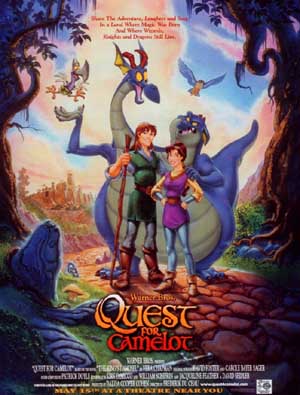Fantasia 2000
Posted on December 13, 2002 at 5:16 am
Almost sixty years ago, the original “Fantasia” was released and hard as it may be to believe it now, the response was unenthusiastic. Today, images like Mickey as the Sorcerer’s Apprentice, the little black Pegasus getting some extra help learning how to fly and the dances of the mushrooms and the ballerina hippos are a part of our culture. Walt Disney hoped that “Fantasia” would be released each year with new episodes, but the lacklustre box office and the distractions of other ventures meant that the idea of adding new material was shelved. Still, the animation studio hoped for another chance, and one of the pleasures of this movie is the chance to see some of the proposals for new episodes submitted by animators over the years.
Disney called the original “a grand mixture of comedy, fantasy, ballet, drama, impressionism, color, sound, and epic fury,” and that well describes the very worthy successor. As the first theatrical release designed exclusively for IMAX screens, it fills the eyes of the audience with splendor. Now on video and DVD, it is still a delight, even better in one respect because you can see the entire screen and catch some of the details that are lost in the vast expanse of the IMAX experience.
The audience is reassured from the beginning that this is not going to be some strange or boring culture lesson. Glimpses and sound clips from the original float into view, and then suddenly we are in the midst of the most famous opening notes of classical music, the da da da DUM of Beethoven’s Fifth, accompanied by an abstract battle between groups of triangles. Then Steve Martin comes on to make a joke, and we’re off to the next episode, whales in moonlight, to Respighi’s “Pines of Rome.” The light on the water, the stillness, the dignity and grace of the whales in the water and then as they float up into the sky are magnificent.
Other segments include a rollicking Al Hirschfeld-inspired look at 1930s New York, to the music of Gershwin’s “Rhapsody in Blue,” a very romantic “Steadfast Tin Soldier” set to Dimitri Shostakovich’s second piano concerto, and a mystical tale about death and rebirth in the forest, to Igor Stravinsky’s “Firebird Suite.” From the original, we get Mickey as the Sorcerer’s Apprentice with glowing colors and dazzling detail. And Donald finally gets his chance, as Sir Edward Elgar’s famous “Pomp and Circumstance” accompanies not a procession of graduates to their diplomas but a procession of animals to Noah’s ark. Celebrities like Angela Lansbury, Quincy Jones, and James Earl Jones provide smooth transitions.
The movie is rated G, but the experience may be overwhelming for some children. A three year old sitting near me in the theater was in tears throughout the first segment, though she enjoyed some of the others. Parents should also know that magicians Penn and Teller do a trick that may scare some kids, though they immediately show that everything is all right.
Families should talk about the way that music makes pictures in our heads, and experiment by asking children to draw pictures as they listen to music. Ask children why the people in “Rhapsody in Blue” are sad, and how they find what they were dreaming of. They may be especially interested in the rich little girl who is dragged around to all kinds of lessons by her nanny, but who dreams of spending time with her busy parents. Talk to them about the spirit of spring in “The Firebird Suite,” who learns that she cannot prevent death, but can help the forest to renew itself. Ask them about “The Steadfast Tin Soldier” (which has a Disney-ized happy ending). Why did the solider first like the ballerina? Why did he think she would not like him? Why was the Jack in the Box so jealous? Show children some of the drawings of legendary artist Al Hirschfeld, who hid the name of his daughter “Nina” in his pictures. Kids who are interested in the adaptation of his work for “Rhapsody in Blue” will enjoy the award-winning documentary about him, “The Line King.”
Families should watch the original, and compare them — one has a segment on the coming of fall and one on the coming of spring, both have music by Stravinsky, both have a non-representational segment, both have a processional number, and both have a funny animal segment — this one “answers the age-old question, ‘What would happen if you gave a flamingo a yo-yo?'” And see if kids can figure out the closest approximation in the new version of the original’s little black Pegasus. All of this may require a repeat viewing, but hardly anyone will object — and it will give you time to search for the Ninas in “Rhapsody in Blue!”
Families who enjoy this movie will also enjoy three new Disney releases on video — originally produced as “Fantasia” follow-ups with modern music. “Melody Time,” “Make Mine Music,” and “Fun and Fancy Free” feature some of Disney’s classic animation, with outstanding segments like “Peter and the Wolf,” “Casey at the Bat,” and “Mickey and the Beanstalk.”
DVD note: The DVD version has some exceptionally entertaining extras, including commentary by Hirschfeld on his segment and a hilarious commentary by Mickey about his experiences making “The Sorcerer’s Apprentice” — he is reassuring that no brooms were harmed in the making of the movie!

